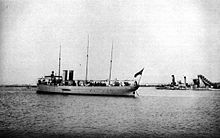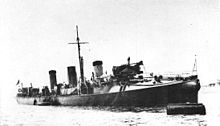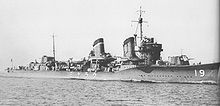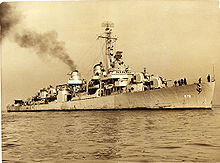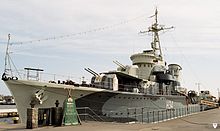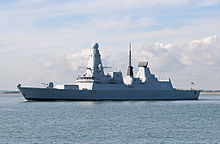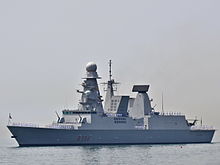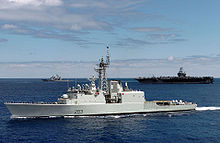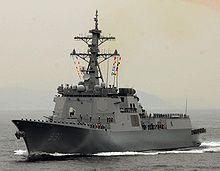- Destroyer
-
For other uses, see Destroyer (disambiguation).
In naval terminology, a destroyer is a fast and maneuverable yet long-endurance warship intended to escort larger vessels in a fleet, convoy or battle group and defend them against smaller, powerful, short-range attackers. Destroyers, originally called torpedo-boat destroyers in 1892,[1] evolved from the response of navies to the threat posed by the torpedo boat. Growing from earlier defensive developments, the torpedo boat destroyer (TBD) first appeared as a distinct class of warship when HMS Havock and Hornet were commissioned into the Royal Navy in 1894.[2][3] By the time of the Russo-Japanese War in 1904, TBDs were "large, swift, and powerfully armed torpedo boats designed to destroy other torpedo boats."[4] Although the term destroyer had been used interchangeably with the terms "TBD" and "torpedo boat destroyer" by navies since 1892, the term torpedo boat destroyer had been generally shortened to simply "destroyer" by nearly all navies by the First World War.[5]
Prior to World War II, destroyers were light vessels with little endurance for unattended ocean operations; typically a number of destroyers and a single destroyer tender operated together. After the war, the advent of the guided missile allowed destroyers to take on the surface combatant roles previously filled by battleships and cruisers. This resulted in larger and more powerful destroyers more capable of independent operation.
At the beginning of the 21st century, destroyers are the heaviest surface combatant ships in general use, with only three nations (the United States, Russia, and Peru) operating the heavier class cruisers and none operating battleships[6] or true battlecruisers.[7] Modern destroyers, also known as guided missile destroyers, are equivalent in tonnage but vastly superior in firepower to cruisers of the World War II era, capable of carrying nuclear missiles. Guided missile destroyers such as the Arleigh Burke class are actually larger and more heavily armed than most previous ships classified as guided missile cruisers, due to their massive size at 510 feet (160 m) long and displacing 9200 tons and armed with over 90 missiles.[1]
Contents
Early history, torpedo boat destroyers
The emergence and development of the destroyer, up until World War II, was related to the invention of the self-propelled torpedo in the 1860s. A navy now had the potential to destroy a superior enemy battle fleet using steam launches to drop torpedoes. Fast boats armed with torpedoes were built and called torpedo boats. By the 1880s, these had evolved into small ships of 50-100 tons, fast enough to evade enemy picket boats.
At first, the danger to a battle fleet was considered only to exist when at anchor, but as faster and longer range torpedoes were developed, the threat extended to cruising at sea. In response to this new threat more heavily-gunned picket boats called "catchers" were built which were used to escort the battle fleet at sea. They needed the same seaworthiness and endurance, and as they necessarily became larger, they became officially designated "torpedo boat destroyers", and by the First World War were largely known as "destroyers" in English. The anti-torpedo boat origin of this type of ship is retained in its name in other languages, including French (contre-torpilleur), Italian (cacciatorpediniere), Portuguese (contratorpedeiro), Polish (kontrtorpedowiec), Czech (torpédoborec), Greek (antitorpiliko,αντιτορπιλικό), and Dutch (torpedobootjager).[8]
Once destroyers became more than just catchers guarding an anchorage, it was realized that they were also ideal to take over the role of torpedo boats themselves, so they were fitted with torpedo tubes as well as guns. At that time, and even into World War I, the only function of destroyers was to protect their own battle fleet from enemy torpedo attacks and to make such attacks on the battleships of the enemy. The task of escorting merchant convoys was still in the future.
An important development came in 1884 with
The Imperial Japanese Navy's Kotaka (1887)
- Screening the advance of a fleet when hostile torpedo craft are about
- Searching a hostile coast along which a fleet might pass
- Watching an enemy's port for the purpose of harassing his torpedo craft and preventing their return
- Attacking an enemy fleet
- List of destroyer classes
- United States Navy 1975 ship reclassification
- Bombardment of Cherbourg, See discussion section for ‘comprised’ versus ‘composed’ usage. See “The Destroyers” article section for a Task Force composed of ships from among five destroyer divisions and their compositions.
- ^ Lyon p. 8
- ^ a b Lyon p. 53
- ^ Evans & Peattie
- ^ Gove p. 2412
- ^ Lyon p. 8, 9
- ^ Although there are currently no active battleships in any navy the United States navy still maintains two Iowa-class battleships, and could reactivate one or both if necessary though unlikely.
- ^ Although the Russian Kirov class are sometimes classified as battlecruisers due to their displacement they are more accurately described as large missile cruisers.
- ^ Lyon p. 8
- ^ "Torpedo Boats". Battleships-Cruisers.co.uk. http://www.battleships-cruisers.co.uk/torpedo_boats.htm.
- ^ Jentschura p. 126
- ^ Evans and Peattie, David C. and Mark R. (1997). Kaigun: Strategy, Tactics, and Technology in the Imperial Japanese Navy, 1887–1941. Annapolis, Maryland: Naval Institute Press. ISBN 0870211927.
- ^ Howe, Christopher (1996). The Origins of Japanese Trade Supremacy: Development and Technology in Asia from 1540 to the Pacific War. Chicago, Illinois: University of Chicago Press. ISBN 0226354857.
- ^ Biography of Villaamil
- ^ From an article about the American Greyhounds
- Quote:
- ^ "Under the influence of Fernando Villamil (1845–1898), Spain in 1886 produced the first torpedo boat destroyer." Kern, Robert & Dodge, Meredith: Historical dictionary of modern Spain, 1700–1988. Greenwood Press, 1990, page 361. ISBN 0-313-25971-2
- ^ Lion, page 18: J&G Thomson's 1892 design for a TBD is, not unsurprisingly, somewhat reminiscent of their "Destructor" built for the Spanish Navy.
- ^ Lion, page 66: It was already (J&G Thomson Clydebank shipyard), when asked to tender for TBDs for the Royal Navy, building transatlantic liners and cruisers to the navy, and had built an interesting torpedo vessel under the prophetic name of "Destructor" ("Destroyer") for Spain. Its first design (for the British navy in 1892) was clearly a successor of the "Destructor".
- ^ Lyon p. 40
- ^ Simpson p. 151
- ^ Lyon p. 121
- ^ Grant p. 136
- ^ Grant, image, frontispiece
- ^ Lyon p. 58
- ^ Jentschura p. 132 (Akatsuki built by Yarrow & Co. in 1902; 224' long, displaced 415 tons, two 18" Torpedoes, two 3" guns, four 57mm Quick Firing Guns, complement 60 officers/men. Sunk by mine at Port Arthur on 17 May 1904)
- ^ a b Grant p. 102, 103
- ^ Simpson p. 100
- ^ Brett, Bernard: "History of World Sea Power", Deans International (London) 1985. ISBN 0-603-03723-2
- ^ Grant p. 42
- ^ Grant p. 33, 34, 40
- ^ U-Boats Destroyed, Paul Kemp (1997), ISBN 1-85409-515-3
- Evans, David C. Kaigun: Strategy, Tactics, and Technology in the Imperial Japanese Navy, 1887–1941, Mark R. Peattie. Naval Institute Press, Annapolis, Maryland ISBN 0-87021-192-7
- Gardiner, Robert (Editor). Conway's All the World's Fighting Ships (1860–1905): Naval Institute Press, 1985.
- Gove, Philip Babock (Editor in Chief). Webster's Third New International Dictionary of the English Language Unabridged. (2002) Merriam-Webster Inc., Publishers, Massachusetts, USA.
- Grant, R. Captain. Before Port Arthur in a Destroyer; The Personal Diary of a Japanese Naval Officer. London, John Murray; first and second editions published in 1907.
- Howe, Christopher. Origins of Japanese Trade Supremacy: Development and Technology in Asia from 1540 to the Pacific War, The University of Chicago Press, ISBN 0-226-35485-7
- Jentschura, Hansgeorg. Warships of the Imperial Japanese Navy, 1869-1945. United States Naval Institute, Annapolis, Maryland, 1977. ISBN 0-87021-893-X.
- Lyon, David, The First Destroyers. Chatham Publishing, 1 & 2 Faulkner's Alley, Cowcross St. London, Great Britain; 1996. ISBN 1-55750-271-4.
- Sanders, Michael S. (2001) The Yard: Building a Destroyer at the Bath Iron Works, HarperCollins, ISBN 9780060929633
- Simpson, Richard V. Building The Mosquito Fleet, The US Navy's First Torpedo Boats. Arcadia Publishing, (2001); Charleston, South Carolina, USA. ISBN 0-7385-0508-0.
- Preston, Anthony. Destroyers, Bison Books (London) 1977. ISBN 0-600-32955-0
- Van der Vat, Dan. The Atlantic Campaign.
- DD-963 Spruance-class
- Navy Designates Next-Generation Zumwalt Destroyer
- The Japanese 1887 Kotaka (Japanese)
- The Spanish 1886 Destructor (Spanish)
- "TIN CANS" can dish it out! July 1945 Popular Science article
- MaritimeQuest Minekaze Class Destroyer Class Overview
- USS Joseph P. Kennedy Photos on board the Destroyer Joseph P. Kennedy DD-780 in Fall River, MA
- USS Slater Photos on board the Destroyer Escort USS Slater DE-766 Museum in Albany, NY
The Japanese torpedo boat[10]Kotaka (Falcon) of 1885 was "the forerunner of torpedo boat destroyers that appeared a decade later".[11] Designed to Japanese specifications and ordered from the London Yarrow shipyards in 1885, she was transported in parts to Japan, where she was assembled and launched in 1887. The 165-foot (50 m) long vessel was armed with four 1-pounder (37 mm) quick-firing guns and six torpedo tubes, reached 19 knots (35 km/h), and at 203 tons, was the largest torpedo boat built to date. In her trials in 1889, Kotaka demonstrated that she could exceed the role of coastal defense, and was capable of accompanying larger warships on the high seas. The Yarrow shipyards, builder of the parts for the Kotaka, "considered Japan to have effectively invented the destroyer".[12]
Almost immediately after the order of Kotaka was placed, Fernando Villaamil, second officer of the Ministry of the Navy of Spain where he was put in charge of developing the concept of a new ship designed to combat torpedo boats,[13] placed an order for a large torpedo gunboat in November 1885, with the British builder James and George Thompson, of Clydebank, not far from where the Yarrow shipyards would move from London 20 years later. The ship, named Destructor (literally Destroyer), was laid down at the end of the year, launched in 1886, and commissioned in 1887. Her displacement was 380 tons, and she was armed with one 90 mm Hontoria gun, four 57 mm Nordenfelt guns, two 37 mm Hotchkiss cannons and 3 Schwarzkopf torpedo tubes. Her complement was 60 men. In terms of gunnery, speed (22.5 knots in trials) and dimensions, the specific design to chase torpedo boats and her high seas capabilities, Destructor is widely considered the first torpedo-boat destroyer ever built.[14][15] The Destructor is thought to have influenced the concept and designation of destroyers developed by the British Navy shortly after.[16][17]
The British Navy began experiments with the "torpedo boat catcher", a class of 17 large torpedo boats. In tests, the Rattlesnake proved to be marginally faster than torpedo boats, but not fast enough to be decisive.
The first ships to bear the formal designation "torpedo boat destroyer" (TBD) were the Daring class of two ships and Havock class of two ships of the Royal Navy, developed in 1892 under the newly appointed Third Sea Lord Rear Admiral "Jackie" Fisher. The Daring and Decoy were ordered on 27 June 1892 from John I. Thornycroft & Company at Chiswick, while the Havock and Hornet were ordered five days later from Yarrow at Poplar. The Daring and Decoy were completed in 1895[18] and the Havock and Hornet were completed in 1894.[2] Each was armed with a single 12-pounder (76 mm) gun, three 6-pounders (57 mm), and three 46 cm torpedo tubes. They also had the range and speed to travel effectively with a battle fleet.
The French navy, an extensive user of torpedo boats, built its first torpedo boat destroyer in 1899, with the Durandal-class 'torpilleur d'escadre'.
The United States commissioned its first torpedo boat destroyer, USS Bainbridge, Destroyer No. 1, in 1902 and by 1906 there were 16 destroyers in service with the US Navy.[19]
Early torpedo-boat-destroyer designs
Torpedo-boat-destroyer designs continued to evolve around the turn of the 20th century in several key ways. The first was the introduction of the steam turbine. The spectacular unauthorized demonstration of the turbine powered Turbinia at the 1897 Spithead Navy Review, which, significantly, was of torpedo boat size, prompted the Royal Navy to order a prototype turbine powered destroyer, HMS Viper of 1899. This was the first turbine warship of any kind and achieved a remarkable 36 knots (67 km/h) on sea trials. By 1910 the turbine had been widely adopted by all navies for their faster ships.
The second development was the replacement of the torpedo boat-style turtleback foredeck by a raised forecastle for the new River class destroyers built in 1903, which provided better sea-keeping as well as more space below deck.
The British experimented with oil propulsion for the Tribal class of 1905 but switched temporarily back to coal for the later Beagle class in 1909. Other navies also adopted oil, for instance the USN with the Paulding class of 1909. In spite of all this variety, destroyers adopted a largely similar pattern. The hull was long and narrow, with a relatively shallow draft. The bow was either raised in a forecastle or covered under a turtleback; underneath this were the crew spaces, extending 1/4 to 1/3 the way along the hull. Aft of the crew spaces was as much engine space as the technology of the time would allow: several boilers and engines or turbines. Above deck, one or more quick-firing guns were mounted in the bows, in front of the bridge; several more were mounted amidships and astern. Two torpedo tube mountings (later on, multiple mountings) were generally found amidships.
Between 1892 and 1914 destroyers became markedly larger: initially 420 tons with a length of 250 feet (76 m) for the US Navy's first Bainbridge class of torpedo boat destroyers,[20] up to the First World War with 300-foot (91 m) long destroyers displacing 1000 tons was not unusual. However, construction remained focused on putting the biggest possible engines into a small hull, resulting in a somewhat flimsy construction. Often hulls were built of steel only 1/8in thick.
By 1910 the steam-driven displacement (that is, not hydroplaning) torpedo boat had become redundant as a separate type. Germany nevertheless continued to build such torpedo boats until the end of World War I, although these were effectively small coastal destroyers. In fact Germany never distinguished between the two types, giving them pennant numbers in the same series and never giving names to destroyers. Ultimately the term torpedo boat came to be attached to a quite different vessel - the very fast hydroplaning motor driven MTB.
Life on torpedo boat destroyers
Early destroyers were extremely cramped places to live, being "without a doubt magnificent fighting vessels"... "but unable to stand bad weather."[21] During the Russo-Japanese War in 1904, the commander of the torpedo boat destroyer IJN Akatsuki[22][23][24] described "being in command of a destroyer for a long period, especially in wartime...is not very good for the health." Stating that he had originally been strong and healthy, he continued, "life on a destroyer in winter, with bad food, no comforts, would sap the powers of the strongest men in the long run. A destroyer is always more uncomfortable than the others, and rain, snow, and sea-water combine to make them damp; in fact, in bad weather there is not a dry spot where one can rest for a moment."[25]
The Japanese destroyer commander finished with, "Yesterday I looked at myself in a mirror for a long time; I was disagreeably surprised to see my face thin, full of wrinkles, and as old as though I were fifty. My clothes (uniform) cover nothing but a skeleton, and my bones are full of rheumatism."[25]
Although officially classified as a torpedo boat in 1898 by the US Navy, the USS Porter, a 175-foot (53 m) long all steel vessel displacing 165 tons, was described by her commander, LT. John C. Fremont, as "...a compact mass of machinery not meant to keep the sea nor to live in...as five sevenths of the ship are taken up by machinery and fuel, whilst the remaining two sevenths, fore and aft, are the crew's quarters; officers forward and the men placed aft. And even in those spaces are placed anchor engines, steering engines, steam pipes, etc. rendering them unbearably hot in tropical regions."[26]
Early torpedo-boat-destroyer tactics and engagements
The torpedo boat destroyer's initial purpose was to protect against torpedo boats, but navies soon appreciated the flexibility of the fast, multi-purpose vessel that resulted. Vice-Admiral Sir Baldwin Walker laid down destroyer duties for the Royal Navy:[27]
The torpedo boat destroyer's first major use in combat came during the Japanese surprise attack on the Russian fleet anchored in Port Arthur at the opening of the Russo-Japanese War on 8 February 1904. Three destroyer divisions attacked the Russian fleet in port, firing a total of 18 torpedoes. However only two Russian battleships were seriously damaged due to the proper deployment of torpedo nets. The Russian flagship, the battleship Tsesarevich, which had her nets deployed, had at least 4 enemy torpedoes "hung up" in them,[28] other warships were similarly saved from further damage by the Russian navy's proper use of torpedo nets.[29]
World War I

While capital ship engagements were scarce in World War I, destroyer units were almost continually engaged in raiding and patrol actions. The first shot of the war at sea was fired on 5 August 1914 by a destroyer of the 2nd Flotilla, Lance, in an engagement with the German auxiliary minelayer Königin Luise. The first British naval casualty was Amphion, the light cruiser leading the 3rd Flotilla, which ran into a mine laid by Königin Luise.
Destroyers were involved in the skirmishes that prompted the Battle of Heligoland Bight, and filled a range of roles in the Battle of Gallipoli, acting as troop’s transports and fire support vessels, as well as their fleet-screening role. Over 80 British destroyers and 60 German torpedo-boats took part in the Battle of Jutland, which involved pitched small-boat actions between the main fleets, and several foolhardy attacks by unsupported destroyers on capital ships. Jutland also concluded with a messy night action between the German High Seas Fleet and part of the British destroyer screen.
The threat evolved by World War I with the development of the submarine, or U-boat. The submarine had the potential to hide from gunfire and close underwater to fire torpedoes. Early-war destroyers had the speed and armament to intercept submarines before they submerged, either by gunfire or by ramming. Destroyers also had a shallow enough draft that torpedoes would find it difficult to hit them.
The desire to attack submarines underwater led to rapid destroyer evolution during the war, which were quickly equipped with strengthened bows for ramming, depth charges and hydrophones for identifying submarine targets. The first submarine casualty to a destroyer was the German U-19, rammed by Badger on 29 October 1914. While U-19 was only damaged, the next month unrestricted submarine warfare in January 1917, destroyers were called on to escort merchant convoys. US Navy destroyers were among the first American units to be dispatched upon the American entry to the war, and a squadron of Japanese destroyers even joined Allied patrols in the Mediterranean. Patrol duty was far from safe; of the 67 British destroyers lost in the war, collisions accounted for 18, while 12 were wrecked.
At the end of the war the state-of-the-art was represented by the British W class.
Inter-war
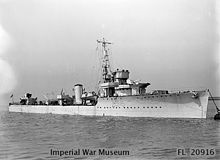
The trend during World War I had been towards larger destroyers with heavier armaments. A number of opportunities to fire at capital ships had been missed during the War, because destroyers had expended all their torpedoes in an initial salvo. The British 'V' & 'W' classes of the late war had sought to address this by mounting six torpedo tubes in two triple mounts, instead of the four or two on earlier models. The 'V' and 'W's set the standard of destroyer building well into the 1920s.
The next major innovation came with the Japanese Fubuki class or 'special type', designed in 1923 and delivered in 1928. The design was initially noted for its powerful armament of six five-inch (127 mm) guns and three triple torpedo mounts. The second batch of the class gave the guns high-angle turrets for anti-aircraft warfare, and the 24-inch (61 cm) oxygen-fueled 'Long Lance' Type 93 torpedo. The later Hatsuharu class of 1931 further improved the torpedo armament by storing its reload torpedoes close at hand in the superstructure, allowing reloading within 15 minutes.
Most other nations replied with similar larger ships. The US Porter class adopted twin five-inch (127 mm) guns, and the subsequent Mahan class and Gridley class (the latter of 1934) increased the number of torpedo tubes to 12 and 16 respectively.

In the Mediterranean, the Italian Navy's building of very fast light cruisers of the Condottieri class prompted the French to produce exceptional destroyer designs. The French had long been keen on large destroyers, with their Chacal class of 1922 displacing over 2,000 tons and carrying 130 mm guns; a further three similar classes were produced around 1930. The Le Fantasque class of 1935 carried five 138 mm (5.4 in) guns and nine torpedo tubes, but could achieve speeds of 45 knots (83 km/h), which remains the record speed for a steamship and for any destroyer.[citation needed] The Italians' own destroyers were almost as swift, most Italian designs of the 1930s being rated at over 38 knots (70 km/h), while carrying torpedoes and either four or six 120 mm guns.
Germany started to build destroyers again during the 1930s as part of Hitler's rearmament program. The Germans were also fond of large destroyers, but while the initial Type 1934 displaced over 3,000 tons, their armament was equal to smaller vessels. This changed from the Type 1936 onwards, which mounted heavy 150 mm guns. German destroyers also used innovative high-pressure steam machinery: while this should have helped their efficiency, it more often resulted in mechanical problems.
Once German and Japanese rearmament became clear, the British and American navies consciously focused on building destroyers that were smaller but more numerous than those used by other nations. The British built a series of destroyers (the A Class to I Class) which were about 1,400 tons standard displacement, had four 4.7-inch (119 mm) guns and eight torpedo tubes; the American Benson class of 1938 similar in size, but carried five 5-inch (127 mm) guns and ten torpedo tubes. Realizing the need for heavier gun armament, the British built the Tribal class of 1936 (sometimes called "Afridi" after one of two lead ships). These ships displaced 1,850 tons and were armed with eight 4.7-inch (119 mm) guns in four twin turrets and four torpedo tubes. These were followed by the J Class and L class destroyers, with six 4.7-inch (119 mm) guns in twin turrets and eight torpedo tubes.
Anti-submarine sensors included sonar (or ASDIC), although training in their use was indifferent. Anti-submarine weapons changed little, and ahead-throwing weapons, a need recognized in World War I, had made no progress.
Operations in the inter-war period
During the 1920s and 1930s destroyers were often deployed to areas of diplomatic tension or humanitarian disaster. British and American destroyers were common on the Chinese coast and rivers, even supplying landing parties to protect colonial interests.
World War II
By World War II the threat had evolved once again. Submarines were more effective, and aircraft had become important weapons of naval warfare; once again the fleet destroyers were ill-equipped for combating these new targets. They were fitted with new anti-aircraft guns, radar, and forward-launched ASW weapons, in addition to their existing light guns, depth charges, and torpedoes. By this time the destroyers had become large, multi-purpose vessels, expensive targets in their own right. As a result, casualties on destroyers were one of the highest. This led to the introduction of smaller and cheaper specialized anti-submarine warships called corvettes and frigates by the Royal Navy and destroyer escorts by the USN. A similar programme was belatedly started by the Japanese (see Matsu class destroyer). These ships had the size and displacement of the original torpedo boat destroyers that the contemporary destroyer had evolved from.
Post-war
Some conventional destroyers were completed in the late 1940s and 1950s which built on wartime experience. These vessels were significantly larger than wartime ships and had fully automatic main guns, unit Machinery, radar, sonar, and antisubmarine weapons such as the Squid mortar. Examples include the British Daring class, US Forrest Sherman-class, and the Soviet Kotlin-class destroyers.
Some World War II–vintage ships were modernized for anti-submarine warfare, and to extend their service lives, to avoid having to build (expensive) brand-new ships. Examples include the US FRAM I programme and the British Type 15 frigates converted from fleet destroyers.
The advent of surface-to-air missiles and surface-to-surface missiles, such as the Exocet, in the early 1960s changed naval warfare. Guided missile destroyers (DDG in the US Navy) were developed to carry these weapons and protect the fleet from air, submarine and surface threats. Examples include the Soviet Kashin-class, the British County class, and the American Charles F. Adams-class.
Modern destroyers
In the US Navy, fleet destroyers operate in support of carrier battle groups, surface action groups, amphibious groups and replenishment groups. The destroyers currently in use by the US Navy are the Arleigh Burke class. Destroyers (with a DD hull classification symbol) primarily perform anti-submarine warfare duty while guided missile destroyers (DDGs) are multi-mission (anti-submarine, anti-aircraft and anti-surface warfare) surface combatants.
The relatively-recent addition of cruise missile launchers has greatly expanded the role of the destroyer in strike and land-attack warfare. As the expense of heavier surface combatants has generally removed them from the fleet, destroyer tonnage has grown (a modern Arleigh Burke class destroyer has the same tonnage as a World War II light cruiser). Arleigh Burke is billed by her builders as ton-for-ton the most powerful warship in history.
The Royal Navy currently operates five ships of the Type 42 class. These ships are due to be replaced by the new type 45, or Daring class, stealth destroyers which will displace roughly 7,200 tonnes. A class of six ships is envisaged, three of which are in service. They will be equipped with the UK variant of the Principal Anti-Air Missile System (PAAMS) and BAE Systems SAMPSON radar.
The Italian Navy and the French Navy each operate two Horizon class destroyers. These stealth ships are armed with the Otomat anti-ship missiles and Aster surface-to-air missiles. The Italian navy currently also operates two Luigi Durand de la Penne class destroyers.
The Canadian Navy currently operates the Iroquois class destroyers, a class of four helicopter-carrying, anti-aircraft, guided missile destroyers (with three remaining in service). They were originally fitted out for anti-submarine warfare, but the entire class underwent major retrofits as a part of the Tribal Class Update and Modernization Program, or TRUMP, in the 1990s. These refits had the effect of re-purposing the ships for air-defence, and the ships are now referred to as area air-defence destroyers.
The Indian Navy operates three Delhi class destroyers. These ships are armed with Kh-35 missiles, which have a range of 130 km, in the anti-ship role. They will be replaced by the Brahmos cruise missiles. Shtil (AKA SA-N-7 Gadfly) system is installed to counter airborne threats. The Barak point-defense missile system has been installed in INS Delhi and will soon be installed in the other two ships of its class. These destroyers also carry the RBU-6000 rockets in the anti-submarine role and are provided with five 533 mm torpedo launch tubes that can launch the SET-65E, Type 53-65 torpedoes. The destroyers have the capability to carry two Sea King helicopters. The Delhi class will be augmented by the new Kolkata class destroyers, the first of which was launched in March 2006.
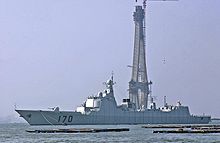
The Chinese People's Liberation Army Navy has recently commissioned a number of new modern destroyers in addition to the four Sovremenny class. Three new classes were launched since 2003, known as the Luyang I, Luyang II and Luzhou classes. The latter two are armed with long range air defense missiles, the indigenous HQ-9 and the Russian S-300 respectively. It has been speculated that once the PLAN has been satisfied with one of the two designs (either the 052C or 051C), it would be selected for series production as the next generation of advanced air defense destroyers for China.
The Republic of Korea navy operates several classes of destroyers including the King Sejong the Great class (KDX-III), the Chungmugong Yi Sun-sin class (KDX-II) and Gwanggaeto the Great class (KDX-I) of destroyers. The KDX-III is equipped with the Aegis combat system, Goalkeeper CIWS, Hyunmoo cruise missile and the Hae Sung anti-ship missile.
Japan's Maritime Self-Defense Force operates the Atago and Kongō class destroyers which both employ the Aegis combat system.
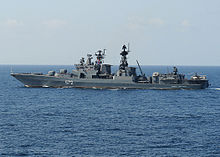
The Russian Navy and the People's Liberation Army Navy of the People's Republic of China operate the Sovremenny class, a class of large multi-purpose missile destroyers. They are powered by pressure-fired boilers, making them capable of speeds in excess of 30 knots (56 km/h). Their armament consists of 8 SS-N-22 Sunburn anti-ship missiles, launchers for SA-N-7 Gadfly anti-air missiles and two AK-130 twin-barreled 130 mm automatic naval guns which can fire laser-guided shells. While they also carry 533 mm torpedo tubes and RBU-6000 rocket launchers for use against submarines, their primary mission is to attack surface ships. Their anti-aircraft missiles have a surface attack mode, and both the 130 mm guns and the torpedoes are useful against ships at close range.
Currently, the most modern destroyers in use with the Russian Navy today is the Udaloy class destroyer. The ships of this class can displace about 7,900 tonnes in a full load, can travel at 35 knots (65 km/h), and have a maximum range of 10,500 kn (19,450 km) at 14 knots (26 km/h). The original class (Udaloy I) was designed for anti-submarine warfare, which can be seen in their two quadruple launchers of the Metel Anti-Ship Complex (SS-N-14), two quadruple 533 millimetres (21 in) launchers equipped with either the Type 53 torpedo on the Udaloy I class or RPK-2 Viyuga (SS-N-15) on the Udaloy II class, and the two RBU-6000 anti-submarine launchers. The II class is Russia's only multipurpose destroyer. The armament of the class has been modified. The Metel Anti-Ship Complex is replaced with eight P-270 Moskit (SS-N-22 Sunburn) supersonic sea-skimming anti-ship missile. For air defense, each Udaloy is armed with four AK-630 CIWSs, mounted parallel to each other mid ship. They also have two Kashtan CIWSs, each capable of engaging 6 targets automatically by either its armament of two GSh-6-30 gatling guns or four 9M311 (SA-N-11) surface-to-air missiles. Finally, 64 3K95 Kinzhal (SA-N-9) medium-range point defense SAMs can be fired from vertical launching system. Currently, a total of 8 Udaloy class destroyers are active, 7 of which are of the Udaloy I class and 1 is of the Udaloy II class.
Future destroyers
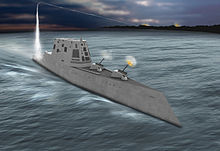
The last US Navy Spruance-class destroyer in service, USS Cushing, was decommissioned on September 21, 2005. The Zumwalt class are planned to replace them; on November 1, 2001, the US Navy announced the issuance of a revised Request for Proposal (RFP) for the Future Surface Combatant Program. Formerly known as DD 21, the program will now be called DD(X) to more accurately reflect the program purpose, which is to produce a family of advanced technology surface combatants, not a single ship class. DD(X), also called Zumwalt class, is much larger than traditional destroyers, being nearly three thousand tons heavier than a Ticonderoga-class cruiser (c.12,500 tonnes, larger than most heavy cruisers from the World War II era). It will potentially employ advanced weaponry and an all-electric Integrated Power System; however, the construction programme was subsequently reduced to just two vessels, and there is currently only funding for three in total. With the retirement of the Spruance class, the Navy began commissioning an advanced variant of the Arleigh Burke class with expanded ASW capabilities, the Arleigh Burke Flight IIA, beginning with USS Oscar Austin. As of 2010[update], 30 of these vessels are in service, with at least six more under construction.


